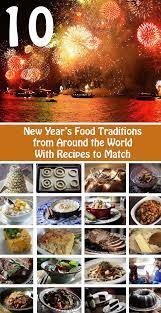As the world welcomes the New Year, diverse culinary traditions take center stage, celebrating fresh starts and invoking good luck through symbolic dishes. From the American South to Japan, each region has its unique fare, reflecting a common theme of indulging in food and drink to invite prosperity for the coming year. Let’s explore ten good-luck servings of New Year’s food traditions around the world:
- Hoppin’ John, American South: A quintessential Southern tradition, Hoppin’ John combines pork-flavored field peas or black-eyed peas (symbolizing coins) with rice, collards (representing money’s color), and cornbread. Rooted in African and West Indian traditions, it is believed to bring good luck for the new year.
- Twelve grapes, Spain: Spaniards indulge in a unique tradition involving eating twelve grapes at the stroke of midnight, symbolizing luck for each month. Originating in the early 20th century, the custom has spread to various Spanish-speaking nations, with meticulous preparation involved.
- Tamales, Mexico: Tamales, corn dough parcels stuffed with savory fillings, take center stage during the holiday season in Mexico. Often prepared collaboratively by groups of women, these delicacies are enjoyed on New Year’s with menudo, a soup known for its hangover-relieving properties.
- Oliebollen, Netherlands: In the Netherlands, oliebollen, or fried oil balls, are a New Year’s Eve delicacy. Resembling doughnuts, these dumplings are deep-fried, dusted with powdered sugar, and sold at street carts and celebratory fairs.
- Marzipanschwein or Glücksschwein, Austria and Germany: Austrian and German New Year’s Eve celebrations involve marzipan pigs (marzipanschwein) and good luck pigs (Glücksschwein). These edible creations, often made of marzipan, signify good fortune and are exchanged as common gifts.
- Soba noodles, Japan: Japanese households partake in toshikoshi soba, or buckwheat soba noodles, at midnight on New Year’s Eve. The long noodles symbolize longevity and prosperity, rooted in a tradition dating back to the 17th century.
- King cake, around the globe: A global tradition, New Year’s cakes come in various forms such as Greece’s Vasilopita, France’s galette des rois, and Mexico’s Rosca de Reyes. Often consumed at midnight, these cakes contain hidden elements like a gold coin, symbolizing a prosperous year for the finder.
- Cotechino con lenticchie, Italy: Italians celebrate La Festa di San Silvestro with cotechino con lenticchie, a sausage and lentil stew representing good luck and prosperity. The feast may include zampone, a stuffed pig’s trotter, and ends with chiacchiere, honey-coated fried dough.
- Pickled herring, Poland and Scandinavia: Abundant in Poland and Scandinavia, pickled herring is consumed at midnight for prosperity. Variations include herring in cream sauce or with onions, with special Polish preparations like Sledzie Marynowane.
- Kransekage, Denmark and Norway: Kransekage, a cake tower made from concentric rings of marzipan, is a Danish and Norwegian tradition for special occasions. Often adorned with ornaments, flags, and crackers, it is a centerpiece for New Year’s Eve celebrations.
As the clock strikes midnight worldwide, these culinary traditions not only satiate appetites but also symbolize the hopes and aspirations for a fortunate and joyous year ahead.
